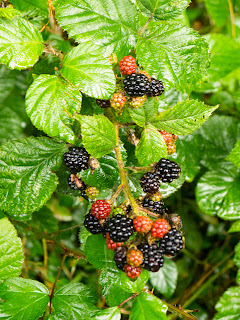Walkers quickly develop a food obsession. Often it’s impossible
to think of anything else as you tramp onwards burning calories along the way.
Alison’s breakfast taken in the dining room of the barn is enormous and magnificent.
Fully sated by fresh strawberries, grapefruit segments, muesli, coffee and
orange juice followed by the main offering of bacon, egg, hash browns, and
sausage, I experience some difficulty bending down to put my boots back on. I carefully smuggle a small sausage portion up to the room for Romney, who makes short work
if it.
The first part of our walk today takes us through the pretty
Ranscombe Farm Reserve and then a section which is far removed from the
original Pilgrims route. In the 12th or 13th century the
travellers would have continued to Snodland and then probably have crossed the
river Medway by ferry at Halling. The ferry only stopped its service in the
1960’s. Or they might have continued to Rochester, crossed the Road Bridge at
Strood and joined up with the Southwark to Canterbury Pilgrims Way along what
is now mostly the A2.
The modern-day pilgrim can cross the new motorway bridge and
this morning it is so gloomy and damp that the castle and cathedral at
Rochester just a few miles up-river are just indistinct outlines on the
horizon. A sign from The Samaritans is attached to the northern extreme of the bridge, which is I suppose, is what the marketing men might call “strategically placed
advertising”. The castle in the drizzly distance is where I spent much of my schooldays
and I was obliged to attend the cathedral every school-day morning (including
Saturdays) for the best part of six years.
Having traversed the metallic grey River Medway, we head into the countryside once more at
Nashenden Farm, a place which stirs powerful and disturbing schoolboy memories
as the location of the much hated school cross-country run. The start point of
this compulsory outdoor torture was this very farm and hundreds of boys in
white gym kit were coerced into running what seemed like hundreds of miles through sticky wet clay.
Ascending above the farm into Leg of Mutton woods, I am
reminded of an incident that has not crossed my mind in more than 30 years.With lungs bursting in the sharp winter air I
remember making a reasonable start one year and being rewarded at the bottom of
the first muddy slope by a flashing smile from one of the most attractive sixth
form girls who was acting as a race steward . I can still picture clearly her coy
look, the direct eye contact, her school scarf protecting her from the December
chill and her long dark curly hair caught by the breeze as she brushed it from her
eyes, revealing her mild skin disorder. How I longed to run my adolescent hands along those woollen navy blue
stockings. The thought still makes me
shudder today.
The thought of the gorgeous sixth former, with the hardly
noticeable skin complaint, inspires me up the hill to a stunning view over the
Medway from Wouldham Common before descending to Blue Bell Hill, the roar of more motorways
and a short rest at Kits Cotie. This is a unique three thousand year old burial chamber
set in a field amongst the motorways but to be frank, this is not the most attractive section of the
trail and I am pleased to move on to Detling.
A minor navigation error forces me to the foot of Detling
Hill but as a result we have to pass over Jade’s Crossing and I am privileged
to be able put a pound coin in the collection box at the foot of the pedestrian
bridge over the busy dual carriageway. Faced with bureaucratic obfuscation, the
feisty villagers of Detling raised their own funds and built their own bridge
over the deadly A249 after the death of Jade and her grandmother. On the opposote side of the crossing we rest
outside the 14th century Cock at Detling before heading down the Pilgrims Way to Thurnham .
The Black Horse at Thurnham is a proper Kentish country pub
complete with dried hops draped from exposed beams, a bread oven, milk churns,
local real ales and a huge Inglenook fireplace. Despite having a fancy
restaurant (local venison steak with chocolate sauce) and posh rooms at £70 plus per night they could not be more welcoming to
a bedraggled middle-aged walker and his overweight exhausted spaniel, both dripping
on the floor of their public bar. I set myself up at a table near the bar and
enjoy an early supper of peppered roast beef baguette with a huge pile of large
chips washed down with a cool pint of Guinness. Sometimes life feels just about
perfect and I am about to offer Romney a cold chip but he has already crashed
out, fast asleep with his head resting on my backpack.
Tonight’s accommodation is a bunkhouse at Coldbow Farm just
about a two miles away across a muddy field and up a steep hill to the crest of
the downs. The temperature is dropping as we arrive and we are shown to our
modest but comfortable suite of bunk beds with access to multiple showers, toilets and a large
kitchen. We are the only guests in the bunkhouses and our hostess tells me it
is rare to see walkers at all these days.
I offer an old England rugby shirt for Romney to use as a blanket and we
are both snoring in perfect unison by 9.45pm.







